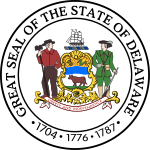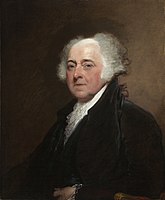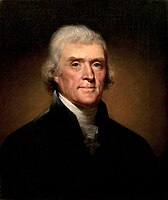
The Twelfth Amendment to the United States Constitution provides the procedure for electing the president and vice president. It replaced the procedure in Article II, Section 1, Clause 3, under which the Electoral College originally functioned. The amendment was proposed by Congress on December 9, 1803, and was ratified by the requisite three-fourths of state legislatures on June 15, 1804. The new rules took effect for the 1804 presidential election and have governed all subsequent presidential elections.

The 1792 United States presidential election was the second quadrennial presidential election. It was held from Friday, November 2, to Wednesday, December 5, 1792. Incumbent President George Washington was elected to a second term by a unanimous vote in the electoral college, while John Adams was re-elected as vice president. Washington was essentially unopposed, but Adams faced a competitive re-election against Governor George Clinton of New York.

The 1796 United States presidential election was the third quadrennial presidential election of the United States. It was held from Friday, November 4 to Wednesday, December 7, 1796. It was the first contested American presidential election, the first presidential election in which political parties played a dominant role, and the only presidential election in which a president and vice president were elected from opposing tickets. Incumbent vice president John Adams of the Federalist Party defeated former secretary of state Thomas Jefferson of the Democratic-Republican Party.

The 1800 United States presidential election was the fourth quadrennial presidential election. It was held from October 31 to December 3, 1800. In what is sometimes called the "Revolution of 1800", the Democratic-Republican Party candidate, Vice President Thomas Jefferson, defeated the Federalist Party candidate and incumbent, President John Adams. The election was a political realignment that ushered in a generation of Democratic-Republican leadership. This was the first presidential election in American history to be a rematch.

The 1820 United States presidential election was the ninth quadrennial presidential election. It was held from Wednesday, November 1, to Wednesday, December 6, 1820. Taking place at the height of the Era of Good Feelings, the election saw incumbent Democratic-Republican President James Monroe win re-election without a major opponent. It was the third and the most recent United States presidential election in which a presidential candidate ran effectively unopposed. As of 2024, this is the most recent presidential election where an incumbent president was re-elected who was neither a Democrat nor a Republican, before the Democratic-Republican party split into separate parties.

In the United States, the Electoral College is the group of presidential electors that is formed every four years for the sole purpose of voting for the president and vice president. The process is described in Article II of the U.S. Constitution. Each state appoints electors using legal procedures determined by its legislature, equal in number to its congressional delegation totaling 535 electors. A 1961 amendment granted the federal District of Columbia three electors. Of the current 538 electors, a simple majority of 270 or more electoral votes is required to elect the president and vice president. If no candidate achieves a majority there, a contingent election is held by the House of Representatives to elect the president and by the Senate to elect the vice president. Federal office holders, including senators and representatives, cannot be electors.

In the United States Electoral College, a faithless elector is an elector who does not vote for the candidates for U.S. President and U.S. Vice President for whom the elector had pledged to vote, and instead votes for another person for one or both offices or abstains from voting. As part of United States presidential elections, each state selects the method by which its electors are to be selected, which in modern times has been based on a popular vote in most states, and generally requires its electors to have pledged to vote for the candidates of their party if appointed. A pledged elector is only considered a faithless elector by breaking their pledge; unpledged electors have no pledge to break. The consequences of an elector voting in a way inconsistent with their pledge vary from state to state.

The election of the president and the vice president of the United States is an indirect election in which citizens of the United States who are registered to vote in one of the fifty U.S. states or in Washington, D.C., cast ballots not directly for those offices, but instead for members of the Electoral College. These electors then cast direct votes, known as electoral votes, for president, and for vice president. The candidate who receives an absolute majority of electoral votes is then elected to that office. If no candidate receives an absolute majority of the votes for president, the House of Representatives elects the president; likewise if no one receives an absolute majority of the votes for vice president, then the Senate elects the vice president.

The 1828 United States presidential election in Delaware took place between October 31 and December 2, 1828, as part of the 1828 United States presidential election. Voters chose three representatives, or electors to the Electoral College, who voted for President and Vice President.
In the United States, a contingent election is used to elect the president or vice president if no candidate receives a majority of the whole number of Electors appointed. A presidential contingent election is decided by a special vote of the United States House of Representatives, while a vice-presidential contingent election is decided by a vote of the United States Senate. During a contingent election in the House, each state delegation votes en bloc to choose the president instead of representatives voting individually. Senators, by contrast, cast votes individually for vice president.

The 1796 United States presidential election in Virginia took place as part of the 1796 United States presidential election. Voters chose 21 representatives, or electors to the Electoral College, who voted for President and Vice President.

The 1796 United States presidential election in Maryland took place on an unknown date in 1796, as part of the 1796 presidential election. Voters chose ten representatives, or electors to the Electoral College, who voted for President and Vice President.

Electoral history of John Adams, who had served as the second president of the United States (1797–1801) and the first vice president of the United States (1789–1797). Prior to being president, he had diplomatic experience as the second United States envoy to France (1777–1779), the first United States minister to the Netherlands (1782–1788), and the first United States minister to the United Kingdom (1785–1788). After losing the 1800 presidential election to Thomas Jefferson, he would mostly retire from political life, with his second youngest son, John Quincy Adams (1767–1848), being elected as the sixth President of the United States (1825–1829) in the 1824 presidential election against Tennessee Senator Andrew Jackson.

The 1804 United States presidential election in Delaware took place between 2 November and 5 December 1804, as part of the 1804 United States presidential election. Voters chose three representatives, or electors to the Electoral College, who voted for President and Vice President.

The 1800 United States presidential election in Delaware took place between 31 October and 3 December 1800, as part of the 1800 United States presidential election. Voters chose three representatives, or electors to the Electoral College, who voted for President and Vice President.

The 1796 United States presidential election in Georgia took place on 4 November 1796, as part of the 1796 United States presidential election. The voters chose four representatives, or electors, through plurality block voting to the Electoral College. These electors then voted for President and vice president.

The 1796 United States presidential election in Kentucky took place between 4 November and 7 December 1796, as part of the 1796 United States presidential election. The voters chose four representatives, or electors to the Electoral College, who voted for President and Vice President.
















